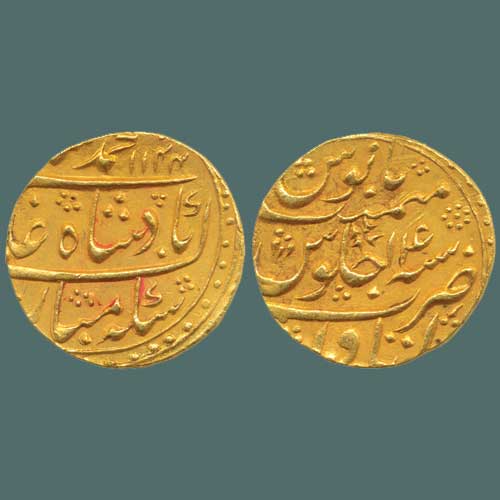Muhammad Shah Gold Mohur Listed For INR 50,000
2018-11-14 Wed
This gold mohur was issued by Mughal Emperor Muhammad Shah during the Hijri year 1144 during the 14th year of his reign.Nasir Al-Din Muhammad Shah was a Mughal Emperor. He sat on the throne in the year 1719 CE when he was 17 years old and ruled it until his death in the year 1748 CE. He sat on Mughal throne with the help of Sayyid brothers; Later he got rid of them with the help of Asaf Jha I. He ruled the Mughal Empire for almost 29 years and his reign is marked as the rapid decline of Mughal Empire. It was during his reign that Nadir Shah attacked Delhi and took the Peacock Throne with him. During his reign, the states of Hyderabad and Awadh established themselves as independent kingdoms. During his reign, the states of Hyderabad and Awadh established themselves as independent kingdoms.
This gold mohur was issued by him from the mint Itawa. The obverse of this coin is inscribed with the name and title of Muhammad Shah with the Hijri year 1144 and the reverse side of the coin is inscribed with Julus formula; mint name Itawa and regnal year 14. This gold mohur is listed for INR 50,000 in the upcoming auction of Todywalla which will be held in Mumbai on 24th November 2018.
Image Courtesy: Todywalla Auction
Latest News
-
Malwa Sultan Mahmud Shah Silver Coins
2025-09-11 ThuMalwa Sultan Mahmud Shah minted silver coins in round and square flans. <br><br> For round coins,...
-
Malwa Sultan Mahmud Shah Billon coin
2025-08-26 TueMalwa Sultan Mahmud Shah's billon coins followed three weight standards: 100 rati, 96 rati, and 80 r...
-
Fascinating Archaeological Facts on Postage Stamps - 91
2025-08-23 SatRhinoceros is one of the oldest land mammal species existing in India. There are five species of rhi...
-
Fascinating Archaeological Facts on Postage Stamps - 90
2025-08-23 SatUthiramerur, a Village in Kanchipuram, Tamil Nadu, is notable for its Temple inscriptions that descr...
-
Fascinating Archaeological Facts on Postage Stamps - 89
2025-08-21 ThuThe term “millet” is derived from the Latin word “milum,” which translates to grain. millets...

